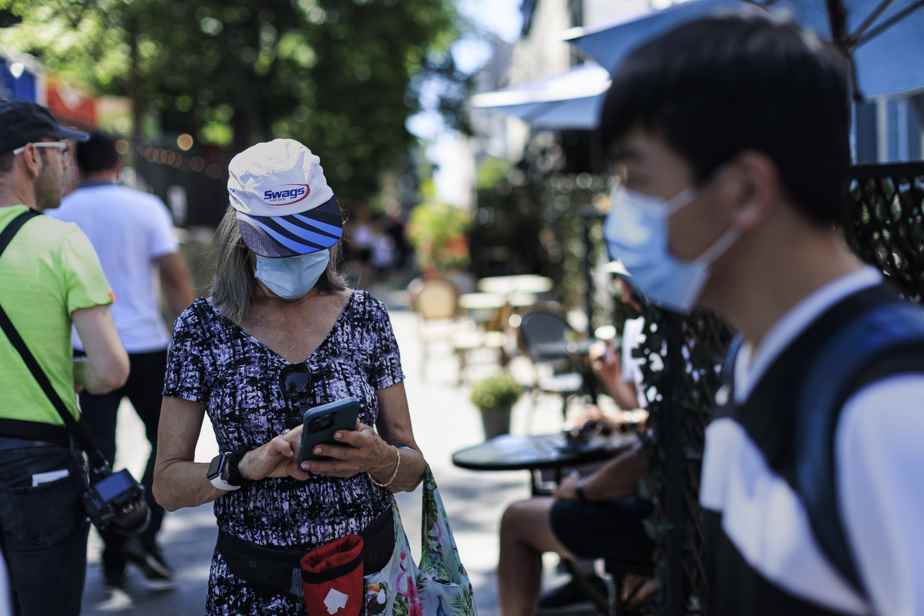The Quebec region has recorded a sharp increase in the number of cases of COVID-19 for ten days, while the situation seems to be stabilizing in the rest of the province. If Quebec crossed the bar of 2,000 hospitalized patients on Wednesday, new projections suggest that the trend should slow down within two weeks in hospitals.
Posted at 12:00 a.m.
Screening in wastewater and PCR tests say the same thing: the spread is on the rise in the Quebec region. The coronavirus rate measured in the sewers of the capital has doubled in the past week. The trend is, however, stabilizing – even decreasing – in the other cities where measures have been taken, namely Montreal, Laval and Gatineau.

In Montreal, the concentration measured in the south interceptor has been decreasing for a week, but on the other hand, it has increased in the north interceptor. These contradictory results thus seem to point to a stabilization. In the northern crown, Laval also shows a stabilization, even a slight drop in the signal of COVID-19 in its wastewater.

As for PCR tests, the data made public on Wednesday by the National Institute of Public Health of Quebec (INSPQ) show that cases have increased for a week by 61% in the Quebec City region, i.e. the Capitale-Nationale and Chaudière-Appalaches. . Cases have only increased by 5% in the rest of the province. Since the beginning of June, that is to say at the beginning of the seventh wave, the region of Quebec has however shown a rate of spread similar to that of the rest of Quebec. A break, however, occurred about ten days ago, when the cases got carried away.
So, while people were enjoying the return of outdoor shows from the Festival d’été de Québec over the past two weeks, the virus was gaining ground in the capital.

At the moment, the cases by age group show that the spread has started to rise again in all groups. Last week, a stabilization of new cases seemed to be taking hold among those under 60. But in the last seven days, the trend has started to rise again. This is particularly the case among young adults (20 to 39 years old), often the first group to observe increases. It therefore remains to be seen whether, as in the previous six waves, the spread will overflow among the oldest, most vulnerable.
The network towards stabilization?
Quebec reported an increase of 97 hospitalizations on Wednesday. The 2,057 people currently hospitalized represent an increase of 16% over one week. Of this number, 57 are in intensive care. For now, the number of people in hospital is likely to continue to rise in the coming days, with the number of admissions continuing to exceed discharges. In fact, there are on average 41 more patients every day.
However, in its new models published on Wednesday, the National Institute for Excellence in Health and Social Services (INESSS) reiterates that it expects a “stabilization of the number of new hospitalizations” in the next two weeks.
The number of hospital admissions linked to the virus would reach “around 180 per day”. However, this is an increase over the organization’s latest projections. Last week, it predicted 160 new hospitalizations per day.
In total, the Institute expects a “stabilization of beds [ordinaires] occupied by COVID patients”, to reach a number between levels 3 and 4 defined by the Ministry of Health and Social Services (MSSS), i.e. approximately 1,900 beds. In the best scenario, we would reach 1688 hospitalizations within two weeks and in the worst, 2139.
Note: 40% of new hospitalizations are “for COVID-19” – the main reason for hospital admission being the coronavirus –, underlines INESSS. The rest of the patients are admitted for other reasons, but test positive for the virus once there, due to high community transmission. The number of patients admitted for COVID-19 has dropped since Omicron’s arrival. During the first waves, it fluctuated between 70% and 80%.
“It’s mainly because people are vaccinated, but also because the Omicron BA.1 to BA.5 variants tend to cause less severe disease. The situation has changed”, launches on this subject the Dr André Veillette, researcher at the Montreal Clinical Research Institute.
Daily report
The 14 new deaths reported on Wednesday brought the daily average calculated over seven days to 15. The trend is up 36% over one week. As in recent days, the number of workers absent due to the pandemic has also increased. They were 7211 Tuesday to have to isolate themselves. The 2,354 new cases reported on Wednesday brought the daily average to 1,971. The trend is thus up 24% over one week. The share of positive PCR tests for COVID-19 remains high, at 15.8%. In addition to the cases detected by PCR tests, 1,325 people have reported in recent days having obtained a positive result from a rapid test. Quebec administers an average of 11,900 doses of vaccine per day. These are mainly people aged 55 and over receiving a fourth dose. To date, 83.6% of Quebecers have received two doses, 52.8% have had three and 15.9% four.
Pierre-André Normandin and Henri Ouellette-Vézina, The Press


